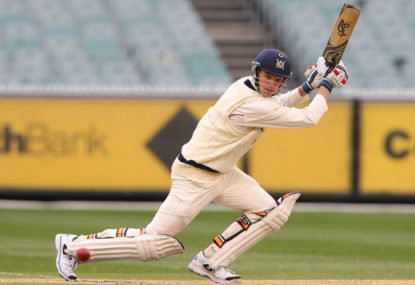The All Time XI For All Time: West Indies
Through electric bowling, dashing batting and acrobatic fielding the West Indies made themselves one of the most popular teams throughout history.

Some cricket observers have responded to Matthew Wade’s underwhelming performance as wicketkeeper by pushing for Peter Handscomb to take the gloves.
I can see the logic – Handscomb has kept, he is a very good batsman, we need a keeper who can bat – problem solved, right? We get two for the price of one?
Well, not necessarily. It could give us twice the trouble – derail Handscomb’s career as a batsman, and give us a second-rate keeper who costs us games.
It’s happened before. Just ask Wayne Phillips.
Remember Wayne Phillips? Not the bald guy who had one Test as an opener in 1992, but the moustached South Australian nicknamed ‘Flipper’ who burst onto the scene in the 1980s, playing 27 Tests and 48 one day internationals.
Phillips made his reputation as a specialist opener for the Redbacks (as they then weren’t know) during the 1981-82 season, scoring 857 first class runs at 47.6. He had occasionally kept wicket – mostly in the under-age teams – and was picked as a batsman and reserve keeper on Australia’s 1982 tour to Pakistan, playing in one ODI.
He made his Test debut in 1983-84 as an opening batsman, scoring 159. Phillips formed a solid opening combination with Kepler Wessels over that summer, making 362 runs at an average of 60. He was a good fielder, fast scorer and his future seemed bright.
However, there was a cloud on the horizon – the wicketkeeping. Rod Marsh’s form with the bat was slipping and people started to suggest Phillips could take over with the gloves. A strong number seven! He can bat, and keep! Two for the price of one! What could go wrong?
We found out on the 1984 tour of West Indies, Australia’s first after Rod Marsh’s retirement. Roger Woolley was meant to take his job; Steve Rixon was overlooked and Phillips picked as batsman and reserve keeper. Woolley was not in form with the gloves. The selectors contemplated dropping Phillips for Steve Smith (the original, not the current one) who was red hot. They decided to kill two birds with one stone by making Phillips the keeper and promoting Smith.
Australia were slaughtered on the tour.
Phillips actually was one of the few Australians to enhance his reputation, with some great knocks (including 120 in the third Test). His keeping was okay, and he played up and down the order that series (batting at seven, two, eight and one), including one Test as a specialist.
Phillips was maintained as keeper for the 1984 tour of India and early in the 1984-85 season he was one of the few Australian batsmen to show fight against the West Indies at home. He missed a few Tests due to injury (being replaced by Rixon) then was back in the chair for the 1985 Ashes. Again, Phillips was one of the better-performing members of a generally unsuccessful squad.
However, it was becoming apparent that Phillips, while being okay keeping to the pacemen, was particularly poor standing up to the spinners. Defections to South Africa meant that Australia’s pace stocks were dangerously weakened, but we had potential match-winning finger men in Bob Holland, Murray Bennett, Greg Matthews and Ray Bright. Phillips’ poor keeping saw chance after chance go down.
We lost at home to New Zealand 2-1 and only rain and the power of Alan Border meant we escaped with a 0-0 draw against India. Phillips was replaced as keeper by Tim Zoehrer for the New Zealand tour and played as a batsman (apart from the odd one dayer). He did well, but was left out of the 1986 tour of India and never played for Australia again.
Phillips was a special batsman – fleet-footed, brave and aggressive. He was not afraid to take the fight to the West Indies at a time when that really meant something. He could’ve been a star of the top order for several years.
But selectors tried to sneak in an extra player by making him keep. It meant he had less time to work on his batting, more ways to lose confidence. It also caused bowlers to lose out on wickets because of catchings and stumpings missed and a general lack of discipline in the field.
Wicketkeeping at Test level is hard. So is batting. We shouldn’t be so cavalier about expecting people to do both. Yes, Adam Gilchrist went from batsman to keeper but he served a long apprenticeship first before going to international level.
Let’s keep Handscomb where he is – reserve keeper only.